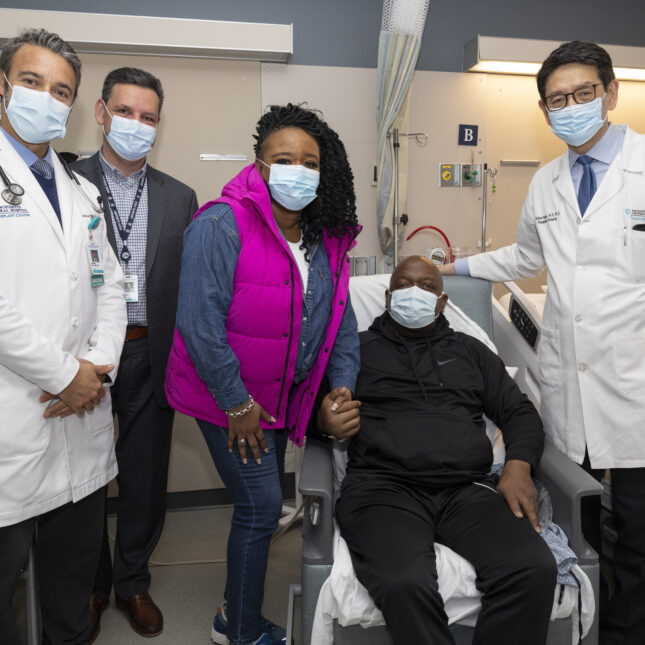
The world’s first recipient of a kidney transplant from a genetically modified pig experienced a rejection episode before recovering and leaving the hospital last week, a Massachusetts General Hospital doctor told STAT. But in his first few days back at home in Weymouth, Mass., the patient — 62-year-old Richard Slayman — had shown no further signs of organ distress.
Rather, he was doing things he hadn’t done in more than a year, like eating whatever he was craving and taking a long, hot shower.
“We couldn’t have hoped for a better outcome,” Leonardo Riella, MGH’s medical director of kidney transplantation, said in an interview Friday.
Slayman had previously received a human kidney transplant, but it failed after five years, requiring him to resume kidney dialysis in 2023. For the past year, he had been spending four hours, three times a week, hooked up to a kidney-filtering machine and was admitted to the hospital every few weeks because of complications with blood clots and other vascular issues. A catheter in his chest intended to help alleviate these issues made it impossible to shower.
“He had been really struggling,” said Riella. “Seeing him leave the hospital off of dialysis has been one of those moments that you kind of remember for life.”
The groundbreaking procedure, performed on March 16, involved a transplant of an engineered porcine kidney, produced by Cambridge, Mass.-based eGenesis. The company employs CRISPR gene editing technology to make dozens of alterations to the pig genome to produce organs more compatible with the human body, in an effort to solve the urgent organ shortage. This is the first in-human test of the technology, after encouraging primate studies were published last year, and the positive outcome so far is an encouraging sign that formal trials of cross-species transplantation may not be far behind.
The pig kidney began producing urine almost as soon as it was surgically connected to Slayman’s circulatory system and it continued to function during his first week in the hospital. Urine tests showed the organ was filtering out toxins and keeping the minerals in his blood, particularly potassium, in proper balance.
But on the eighth day, the kidney began showing signs that it was struggling. Doctors performed a biopsy and discovered that white blood cells had started to infiltrate the transplanted organ, causing swelling and inflammation — classic signs of the most common type of acute graft rejection, known as cellular rejection. It’s something transplant nephrologists like Riella see in about 20% of patients receiving kidneys from human donors, and is treatable using high doses of steroids and a drug that depletes the body’s ranks of T cells.
Slayman’s doctors started him on these drugs, and after a tense three days, his body began to respond to treatment and his new kidney’s function improved. They also upped the immunosuppressant regimen he will be on for the foreseeable future as a precautionary measure against future rejection episodes.
Cellular rejection can happen any time, but especially within the first year of an organ transplant. Riella said having it happen so soon might actually be a good thing. “I would rather get a rejection very early and get it treated and make adjustments rather than seeing it much later where it might go unnoticed for a couple weeks, at which point it might be too late,” he said. “It’s a bit like a wildfire; you want to extinguish it quickly before it gets out of control.”
The transplant team at MGH will continue to monitor Slayman with blood and urine tests three times a week as well as twice-weekly doctor visits. They’ll be looking for signs of rejection and for infections — which he’s more prone to acquiring while on medications that tamp down his immune system.
For the first two months, they’re recommending he not return to his job as a manager at the Massachusetts Department of Transportation. And during that time, they’re also screening his blood weekly with metagenomic sequencing technology, which picks up fragments of DNA from any pathogens that might be circulating.
“We’re doing this passive surveillance to look for things he might be picking up from the outside world, or transmission coming from the donor,” Riella said. eGenesis pigs’ genomes have been edited to remove the risk that they can pass on porcine viruses to humans, a concern that froze the xenotransplant field for most of the 2000s.
But regulators in the U.S. remain worried about the possibility, particularly after a genetically modified pig heart made by a different company, Revivicor, was discovered to have been unknowingly infected with a pig virus, which may have contributed to a xenotransplant patient’s death in 2022, two months after the surgery at the University of Maryland Medical Center.
So far, Slayman is faring better than either of the two patients who received Revivicor pig hearts at the University of Maryland — the only two other people in the world to have had a genetically modified pig organ stitched inside them. A second patient, who underwent the procedure last September, began to show signs of organ rejection a month post-surgery and died two weeks later.
Despite his patient’s progress, Riella said it’s too soon to begin discussions with the Food and Drug Administration about performing another pig kidney transplant under compassionate use, the regulatory pathway that allowed Slayman to get the organ outside of a clinical trial. The transplant team at MGH and eGenesis executives are in ongoing discussions with the agency about initiating a clinical trial, he said.
This story has been updated to correct details of Dr. Riella’s medical expertise.
To submit a correction request, please visit our Contact Us page.










